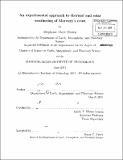| dc.contributor.advisor | Linda T. Elkins-Tanton. | en_US |
| dc.contributor.author | Brown, Stephanie Marie,Ph.D.Massachusetts Institute of Technology. | en_US |
| dc.contributor.other | Massachusetts Institute of Technology. Dept. of Earth, Atmospheric, and Planetary Sciences. | en_US |
| dc.coverage.spatial | zme---- | en_US |
| dc.date.accessioned | 2012-01-30T17:01:15Z | |
| dc.date.available | 2012-01-30T17:01:15Z | |
| dc.date.copyright | 2011 | en_US |
| dc.date.issued | 2011 | en_US |
| dc.identifier.uri | http://hdl.handle.net/1721.1/68892 | |
| dc.description | Thesis (S.M.)--Massachusetts Institute of Technology, Dept. of Earth, Atmospheric, and Planetary Sciences, 2011. | en_US |
| dc.description | Cataloged from PDF version of thesis. | en_US |
| dc.description | Includes bibliographical references (p. 47-51). | en_US |
| dc.description.abstract | Mercury MESSENGER aims to map the composition of the Mercurian crust. This composition has direct implications for the formation and evolution of the planet (Solomon, 2003). The instruments that will compositionally map the surface are calibrated and compared with materials in an Earth-like environment. However, minerals on the surface of Mercury are periodically exposed to the solar wind (radiation) while being heated to over 700 K and cooled to below 100 K daily (Madey et al., 1998; Hale and Hapke, 2002). To understand how these effects will change interpretations of spectra taken from MESSENGER and to understand interactions between the space environment and the crust we are simulating the space-weathering environment on minerals we expect to find on the surface of Mercury. We irradiate with fast neutrons and/or heat the low-iron minerals anorthoclase feldspar, enstatite orthopyroxene, and diopside clinopyroxene. Our results indicate that sodium rich feldspars have the potential to contribute sodium to the exosphere, but in order to to produce potassium from the surface, more potassium rich felspars may be necessary. Calcium and magnesium are released from diopside clinopyroxene while enstatite orthopyroxene is relatively unaffected by weathering. This may indicate that there is more clinopyroxene on the surface of Mercury than orthopyroxene in areas correlating to calcium and magnesium source regions. The variable space weathering effects between minerals may have important consequences in the exosphere. In addition, we also observe interactions between these processes which may help explain small scale patterns of exospheric species on Mercury. We stress the need to create spectral libraries that reflect space weathering environments of materials. | en_US |
| dc.description.statementofresponsibility | by Stephanie Marie Brown. | en_US |
| dc.format.extent | 51 p. | en_US |
| dc.language.iso | eng | en_US |
| dc.publisher | Massachusetts Institute of Technology | en_US |
| dc.rights | M.I.T. theses are protected by
copyright. They may be viewed from this source for any purpose, but
reproduction or distribution in any format is prohibited without written
permission. See provided URL for inquiries about permission. | en_US |
| dc.rights.uri | http://dspace.mit.edu/handle/1721.1/7582 | en_US |
| dc.subject | Earth, Atmospheric, and Planetary Sciences. | en_US |
| dc.title | An experimental approach to thermal and solar weathering of Mercury's crust | en_US |
| dc.type | Thesis | en_US |
| dc.description.degree | S.M. | en_US |
| dc.contributor.department | Massachusetts Institute of Technology. Department of Earth, Atmospheric, and Planetary Sciences | en_US |
| dc.identifier.oclc | 773576983 | en_US |
